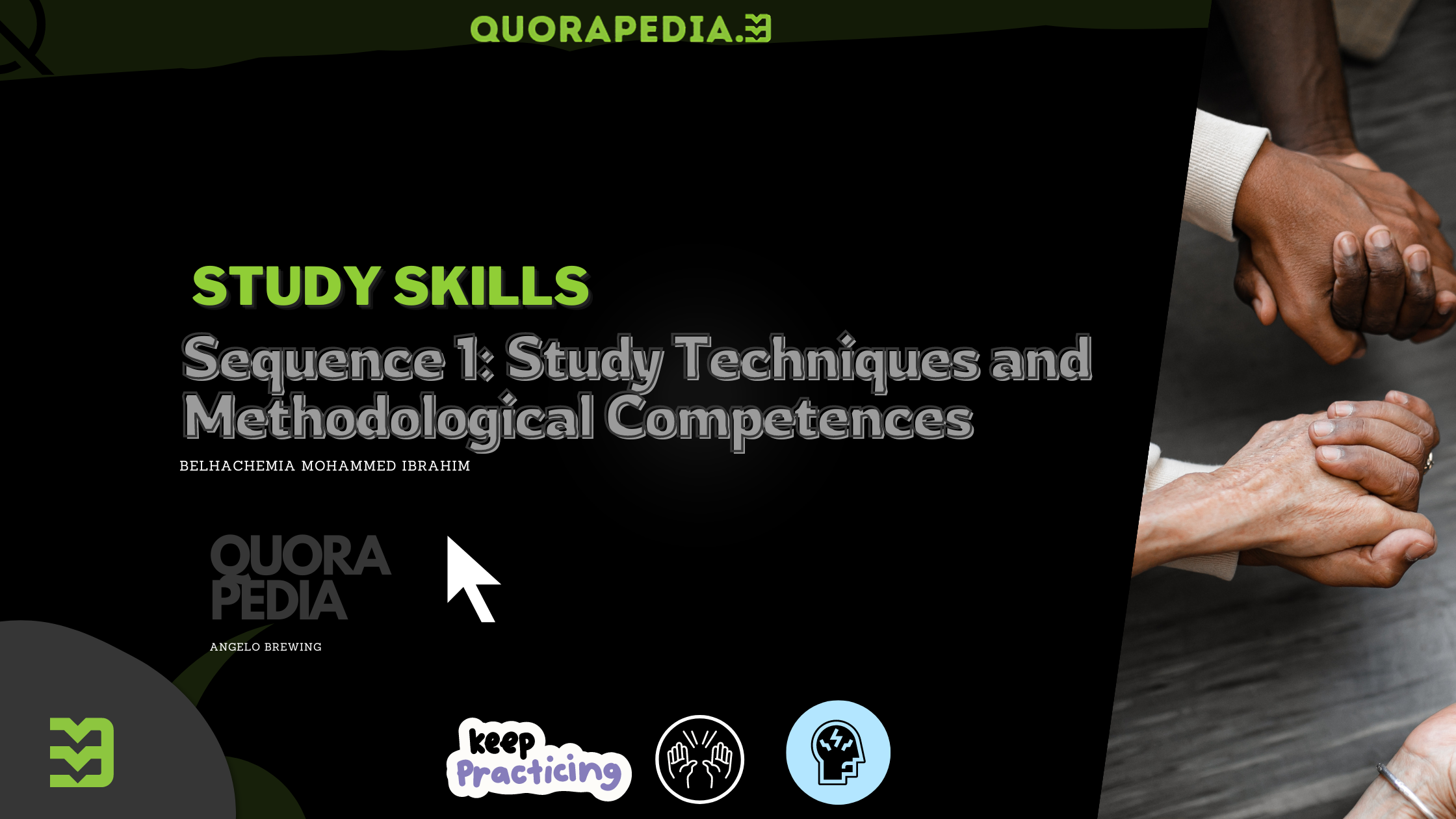
Sequence 1: Study Techniques and Methodological Competences
Essay Topic: Discuss the importance of integrating both study techniques and strategies to achieve academic success. Use examples from the content discussed in Sequence 1 to illustrate how these methods can be practically applied across different academic fields.
Exam Questions:
- Define the difference between study techniques and study strategies. Provide two examples of each from the content.
- Explain how the SQ3R method can be applied to enhance comprehension and retention of academic texts.
- Discuss the role of time management in achieving academic objectives as outlined in Sequence 1.
Sequence 2: Searching and Recording Information
Essay Topic: Analyze the role of different types of information (e.g., textual, numerical, digital) in academic research. Include discussions on the implications of using various information sources, such as primary, secondary, and tertiary sources, as detailed in Sequence 2.
Exam Questions:
- Differentiate between primary, secondary, and tertiary sources of information. Provide an example of each and discuss when each type should be used in academic research.
- What are the key characteristics that define reliable and useful information? Choose three characteristics discussed in Sequence 2 and explain their importance in research.
- Describe the process and importance of recording information accurately during research as explained in Sequence 2.
Sequence 3: Student’s Identity Development and Self-Actualization
Essay Topic: Explore the concept of identity development in students, incorporating the stages such as self-identity exploration and social identity development. Discuss how educational environments and peer influences contribute to identity formation as outlined in Sequence 3.
Exam Questions:
- Explain the concept of self-actualization and how it relates to achieving one’s full potential as a student, as discussed in Sequence 3.
- Discuss the influence of family and cultural background on a student’s identity development. Provide examples from the sequence to support your arguments.
- List and explain the key factors that facilitate a student’s journey towards self-actualization and achieving full potential, as outlined in Sequence 3.
Sequence 1: Study Techniques and Methodological Competences
1. Difference Between Study Techniques and Study Strategies:
- Study Techniques refer to specific methods or approaches that help students to process, organize, and retain information during the learning process. Examples include creating flashcards and practicing active reading.
- Study Strategies involve broader plans and approaches aimed at achieving learning objectives and improving overall academic performance. Examples include setting goals and using metacognitive strategies.
2. Application of the SQ3R Method:
- The SQ3R method, which stands for Survey, Question, Read, Recite, and Review, enhances comprehension and retention by systematically approaching text. Students start by surveying the material to get an overview, formulate questions about the content, read actively to find answers, recite key information aloud, and review the material to reinforce learning.
3. Role of Time Management in Achieving Academic Objectives:
- Time management is crucial in achieving academic objectives as it helps students prioritize tasks, allocate adequate time for studying, and avoid last-minute stress. Effective time management allows for a balanced approach to academic and personal life, enhancing productivity and reducing burnout.
Sequence 2: Searching and Recording Information
1. Differentiation of Information Sources:
- Primary Sources: Original and firsthand data like research studies or interviews. Example: An original research paper.
- Secondary Sources: Analyze, interpret, or summarize information from primary sources. Example: A textbook that explains various scientific theories.
- Tertiary Sources: Compile and distill information from primary and secondary sources, providing overviews or summaries. Example: An encyclopedia entry.
2. Key Characteristics of Reliable Information:
- Accuracy: Ensures the information is free from errors and provides a true representation of facts.
- Relevance: The information is directly related to the specific purpose or topic, making it crucial for informed decision-making.
- Reliability: Information is trustworthy and consistent, typically based on credible sources.
3. Importance of Accurate Information Recording:
- Recording information accurately is essential for maintaining the integrity of research, ensuring that data and sources can be verified and revisited. It aids in avoiding plagiarism by providing clear references and supports the synthesis of information to build coherent arguments or findings.
Sequence 3: Student’s Identity Development and Self-Actualization
1. Concept of Self-Actualization:
- Self-actualization refers to the realization of one's talents and potential, often described as becoming the best version of oneself. In students, it involves recognizing and developing their unique abilities and aligning their academic and personal growth towards achieving their highest aspirations.
2. Influence of Family and Cultural Background:
- Family and cultural backgrounds significantly impact a student's identity development. These factors shape their values, traditions, and expectations, which influence their goals and how they perceive themselves. For example, a student from a family that values education highly may prioritize academic achievements.
3. Key Factors Facilitating Self-Actualization:
- Factors include setting clear goals, developing effective study skills, managing time well, prioritizing self-care, seeking help when needed, and maintaining a positive and growth-oriented mindset. These help students maximize their potential and navigate the challenges of academic life effectively.





